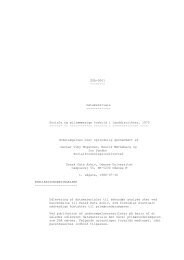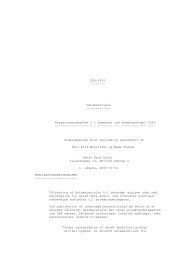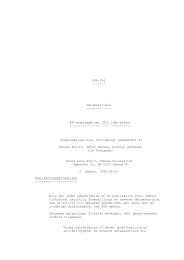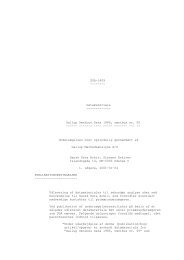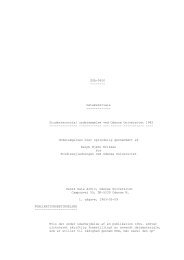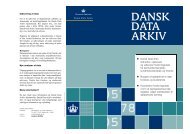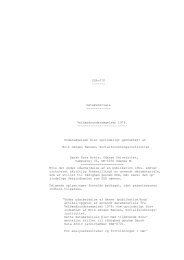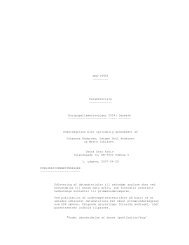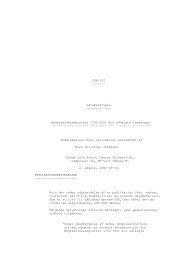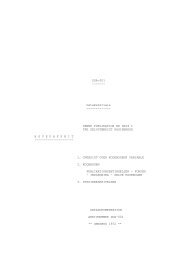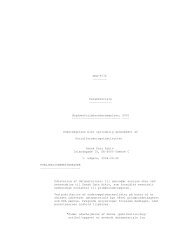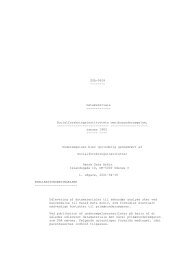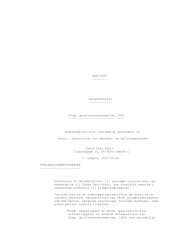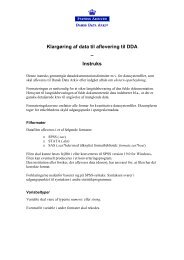Metode og Data nr. 86 - DDA Samfund - Dansk Data Arkiv
Metode og Data nr. 86 - DDA Samfund - Dansk Data Arkiv
Metode og Data nr. 86 - DDA Samfund - Dansk Data Arkiv
You also want an ePaper? Increase the reach of your titles
YUMPU automatically turns print PDFs into web optimized ePapers that Google loves.
Medical research studies<br />
processed to class D<br />
<strong>DDA</strong>-0280 „Nordhavn Repair Yard<br />
Survey, 1976-1979“<br />
(Lars Iversen and Hans Klausen)<br />
The Nordhavn Repair Yard Survey 1976-<br />
1979 consists of two main parts: Part I:<br />
Working Environmental Problems at the<br />
Nordhavn Repair Yard, 1976, and Part II:<br />
Consequences of the Nordhavn Repair Yard<br />
Closedown, 1977-1979.<br />
Part I examines working environmental<br />
problems at the Nordhavn Repair Yard<br />
(employing approx. 100 workers), and Part II<br />
(consisting of 3 follow-up surveys) examines<br />
the consequences (occupational, social,<br />
family, health and financial consequences)<br />
of the Nordhavn Repair Yard closedown for<br />
the workers.<br />
The purpose of the original survey (Part I)<br />
was to examine the workers’ attitudes,<br />
individually and collectively, to working<br />
environmental and health problems. The<br />
importance of safety organizations and unions<br />
at firm level was assessed. And the survey<br />
demonstrated that activities concerned with<br />
improving the working environment were an<br />
integrated part of industrial activity in general,<br />
and that working environmental improvements<br />
always had to be imposed on the employers.<br />
Part II:<br />
6 months after the data collection, the<br />
Nordhavn Repair Yard closed down. Because<br />
of this, the primary investigators decided to<br />
carry out 3 follow-up surveys to find out<br />
what the costs and consequences of this<br />
closedown were for the workers with regard<br />
to occupation, financial conditions and health,<br />
as well as with regard to their exclusion from<br />
the labour market.<br />
(Follow-Up Survey I was carried out in<br />
1977, Follow-Up Survey II in 1978, and<br />
Follow-Up Survey III in 1979).<br />
File dimensions: 100 cases, 631 variables.<br />
<strong>DDA</strong>-0363 Fertility and Occupation<br />
in Denmark, 1979<br />
(Pamela Rachootin and Jørn Olsen)<br />
The purposes of the survey are 1) to assess the<br />
methodol<strong>og</strong>ical problems connected with the<br />
use of patients under medical treatment for<br />
infertility as study subjects in an epidemiol<strong>og</strong>ical<br />
study of the relationship between<br />
occupation and fertility, 2) to estimate the<br />
prevalence of reduced fertility and spontaneous<br />
abortions as well as to estimate the<br />
average time required for conception, and 3)<br />
to examine the types of occupation associated<br />
with reduced fertility, spontaneous abortion<br />
and stillbirth.<br />
All the data were collected in interviews<br />
with a stratified random sample of approx. 1.4<br />
per thousand Danish females between 25 and<br />
45. The sample consisted of a total of 953<br />
women, and 74.4% of these were interviewed.<br />
The interviews were carried out as part of the<br />
omnibus survey which was carried out by<br />
Danmarks Statistik and the Danish National<br />
Institute of Social Research in October 1979<br />
(<strong>DDA</strong>-0522). The questionnaire included<br />
information about present and former occupation<br />
of the woman and her husband/cohabitant,<br />
female reproductive history (including<br />
time required for conception, medical consultations<br />
for infertility problems, number of<br />
pregnancies, result of pregnancies, etc.) as<br />
well as socio-dem<strong>og</strong>raphic information.<br />
File dimensions: 709 cases, 149 variables.<br />
<strong>DDA</strong>-0705 „Female Brewery Workers:<br />
Medicine and Working Environment,<br />
1980“<br />
(Lone Wibroe)<br />
The purposes of the survey are:<br />
1. To describe what types of medicine and the<br />
extent to which they are used in a specific<br />
working environment.<br />
<strong>Metode</strong> & <strong>Data</strong> <strong>nr</strong>. <strong>86</strong> – 2002 side 52




